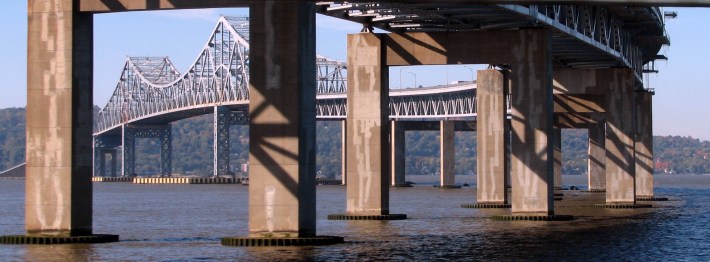Last month Streetsblog asked whether President Obama would select transportation projects that reduce congestion, improve air quality, and create jobs when he picked several infrastructure investments, among those recommended by agency officials, to fast-track. The selection of these projects, intended to help spur short-term job creation, could avoid the mistakes of the 2009 stimulus program, which funneled billions to “shovel-ready” projects that will also promote sprawl. Leading up to the announcement, the president’s rhetoric seemed to indicate that the administration would opt for road maintenance and transit projects rather than newer, wider highways.

Today the administration announced its list of 14 projects, and at first glance, it seems like most of the transportation-related projects take transit, bicycling, and walking into consideration. Some of them will induce sprawl nonetheless, because they expand traffic capacity.
These projects won’t get more federal funds, but they will get federal help in expediting the process. The president promised that this fast-tracking won’t shortchange environmental reviews. The projects were highlighted by officials in several agencies and final selection was done by the White House.
Here’s the list of surface transportation-related projects, most of them recommended by the Department of Transportation:
Tappan Zee Bridge, New York: The bridge is rated structurally deficient as well as functionally obsolete, meaning that in addition to carrying more traffic than it was designed for, the structure is unsafe to carry vehicles. Constant repairs have made the bridge into a money pit, and a significant overhaul could produce long-term savings on maintenance. Notably, this project is not close to “shovel-ready” status, so its selection seems to indicate that the administration had long-term goals in mind, in addition to short-term job creation. There are plans to include a Bus Rapid Transit lane and a commuter rail line on the bridge, as well, but some advocates worry that all that widening could happen without the transit components coming through in the end.
Crenshaw/LAX, California: LA Mayor Antonio Villaraigosa has become a champion for federal loan programs because of his zeal to expand transit in his city. The Crenshaw/LAX project is a cornerstone of his efforts and will provide a critical transit connection to the airport. The city has done a good job attracting federal interest and assistance, and the FTA is already helping them shorten the approval time for the project.
Whittier Bridge, Massachusetts: A conventional bridge along I-95 will be replaced with a wider bridge that will add vehicle lanes as well as bicycle and pedestrian facilities. While the multi-modal treatment is encouraging, the project appears to be a typical highway-widener with a gloss of bicycle- and pedestrian-friendliness added on.
Provo Westside Connector, Utah: This is the only pure road capacity project on the list. It would build a new arterial roadway between the airport and I-15. Its proximity to wetlands has led to some controversy among residents. Some are also concerned that it would increase traffic and sprawl. The mayor has insisted that the dissent won’t change his mind about going forward with the project.
Baltimore Red Line, Maryland: An east-west transit line that’s been in the works for years but was delayed due to competing proposals for BRT or heavy rail. The 14-mile light rail line provides an alternative to driving on I-40, connecting the suburban areas west of Baltimore to downtown, the Inner Harbor, and the Johns Hopkins. There are several outstanding permitting issues, and federal intervention to smooth the process could be key. The White House estimates that administration support can save the project two years, where most of the projects are slated for about six months’ savings.
City Market at O Street, District of Columbia: Every city has big tracts of city land that are fenced off and lying idle, and most of the time you just hope that there’s some plan to do something great with it at some point. One of those big vacant spaces in DC is about to get a $260 million mixed-used development project. They’ll renovate the historic, 120-year-old O Street Market, rebuild a supermarket, and build 400 market-rate apartments, 145 high-end condominiums, a 180-room hotel and 86 units of affordable senior housing. As part of expediting the review process, the federal government will help the District navigate the historic preservation permitting process. This project was recommended by HUD.
There are also projects dealing with aviation, water treatment, subsidized housing, habitat restoration, wind generation, and oil and gas exploration on prairie and grasslands.
The administration says it’s also gathering best practices from all the agencies to develop recommendations to improve the efficiency, effectiveness, transparency and accountability of federal permitting and environmental review, “without compromising our responsibility to protect safety, public health, and the environment.” They’re thinking about measures like sector-specific guidelines for timely reviews of permitting applications; encouraging early engagement with stakeholders; coordinating federal reviews with those of state, local and tribal regulatory agencies; and instituting greater oversight of the overall process.
What do you think of this list, Streetsblog readers? Can you share some insight into any of these projects listed above?





